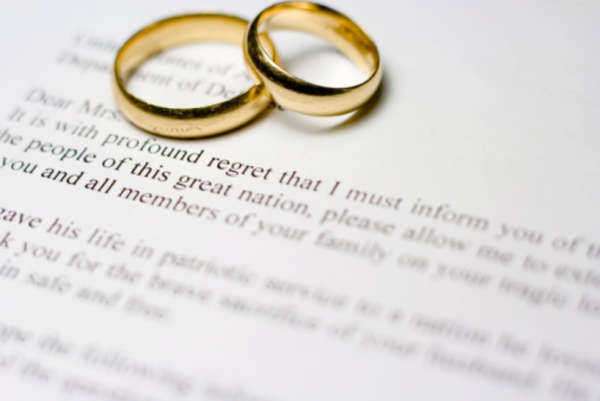
Read to Understand Common Law Marriage
Marriage has been an institution that has existed for centuries. It is a legal union between two people that binds them together. However, there are different types of marriages, including civil, religious, common law, and same-sex marriages. In this article, we will focus on common-law marriages, which have gained popularity in recent years.
What is Common Law Marriage?
A common law marriage is a type of marriage that is recognized in some states in the United States. It is a marriage that is formed by two people who have not obtained a marriage license or participated in a formal wedding ceremony. In other words, a common-law marriage is an informal marriage that is created by the actions and behavior of the couple.
In a common-law marriage, the couple must cohabit and hold themselves out as a married couple. This means that they must present themselves to the public as a married couple and that they must intend to be married. The couple must also have a mutual agreement to be married and must live together for a certain amount of time.
State Recognition of Common Law Marriage
Common law marriages are recognized in some states in the USA. Each state has different requirements for forming a common-law marriage. Currently, only 11 states and Washington D.C. recognize common law marriages. These states include:
1. Alabama
2. Colorado
3. District of Columbia
4. Georgia (if created before 1/1/97)
5. Idaho (if created before 1/1/96)
6. Iowa
7. Kansas
8. Montana
9. New Hampshire (for inheritance purposes only)
10. Oklahoma
11. Rhode Island
12. South Carolina
These states have different requirements regarding the duration of cohabitation and the intent of the couple to be married. In some states, the couple may need to live together for a certain number of years, while in others, there is no minimum requirement.
The Benefits of Common Law Marriage
The main advantage of a common-law marriage is that it provides legal recognition and protection for the couple. In a common-law marriage, the couple is entitled to certain legal rights and benefits, such as:
1. Social Security Benefits: A surviving partner is entitled to receive Social Security benefits if their partner dies.
2. Inheritance: A spouse is entitled to inherit assets from their partner if they die intestate (without a will).
3. Property Rights: In a common-law marriage, each partner has a legal claim on any property acquired during the relationship.
4. Medical Decisions: A spouse in a common-law marriage can make medical decisions for their partner if they are unable to make them.
5. Alimony: In some states, a spouse in a common-law marriage may be entitled to alimony if the relationship ends.
6. Child Custody and Support: In a common-law marriage, each partner has the same rights and responsibilities regarding child custody and support as any other married couple.
7. Legal Separation and Divorce: In some states, common-law marriages are subject to the same legal separation and divorce laws as formal marriages. This means that if the couple decides to separate or divorce, they will need to go through a legal process to divide assets and determine custody and support.
How to Create a Common Law Marriage
To create a common-law marriage, the couple must first meet the requirements set by the state in which they live. In general, these requirements include:
1. Cohabitation: The couple must live together as a married couple. This means sharing a residence, sleeping in the same bed, and maintaining a household.
2. Mutual Agreement: The couple must have a mutual agreement to be married. This means that they must be on the same page about the fact that they are in a committed relationship and that they intend to be together long-term.
3. Intent to be Married: The couple must intend to be married. This means that they must hold themselves out as a married couple to the public and have the same rights and responsibilities of a married couple.
Common Myths about Common Law Marriage
There are many myths and misconceptions about common-law marriages. Some of the most common myths include:
1. Myth: Living together for a certain amount of time automatically creates a common-law marriage in all states.
Fact: Each state has different requirements for creating a common-law marriage. Some states require a minimum period of cohabitation, while others do not.
2. Myth: You cannot have a common-law marriage and a formal marriage at the same time.
Fact: In most states, you cannot be married to two people at the same time. However, it is possible to have a common-law marriage and later get a formal marriage license.
3. Myth: Common law marriages are only recognized in certain states.
Fact: Common law marriages are recognized in some states, but not all. The requirements for creating a common-law marriage vary by state.
4. Myth: A common-law marriage can be ended through a simple agreement between the couple.
Fact: In most states, common-law marriages must be dissolved through a legal process, just like a formal marriage.
Conclusion
Common law marriage is an informal type of marriage that is recognized in some states in the USA. Each state has different requirements for creating a common-law marriage, but in general, the couple must cohabit and hold themselves out as a married couple. The main advantage of a common-law marriage is that it provides legal recognition and protection for the couple, including social security benefits, inheritance rights, property rights, medical decision-making, child custody and support, and legal separation and divorce. It is important to note that common-law marriages are subject to the same laws and regulations as formal marriages. Therefore, it is essential to understand the requirements for creating a common-law marriage, as well as the legal process for dissolving it.
Background:
Common-law marriage predates marriage granted through the use of a marriage license.
In fact, the only difference in principle between marriage and common law marriage is the use of a marriage license.
Common-law marriage is granted only when couples meet stringent requirements prescribed by their state of residence.
Those requirements vary in states that legally recognize common-law marriages. Generally, the requirements are fairly standard, but couples must be sure that they meet their state’s requirements to avoid difficulties later.
In states that grant common-law marriages, requirements are generally similar to the requirements for obtaining a marriage license, while removing the necessity of a marriage ceremony.
However, once the marriage has been granted, there can be many other differences between the two types of marriage.
For example, couples in common-law marriages may not have access to all of the rights and responsibilities conferred upon marriages. In some states, couples may not even be legally allowed to be granted a common-law marriage.
In states that do allow common law marriage, the rights associated with that relationship will also vary. Some states view common law marriage in the same way that they view marriage.
However, some states offer only limited rights and responsibilities to common law marriage.
The idea of Common Law:
Common-law marriage is often used by individuals who are opposed to government control of relationships.
With the requirement of a marriage license for most marriages came more government control over which couples were granted the right to marry.
Originally, only white couples were allowed to obtain a marriage license in the United States; interracial couples were forbidden from getting marriage licenses. Currently, most same-sex couples in the United States are forbidden from obtaining a marriage license.
In this way, the government controls which couples are allowed to obtain legal recognition of their marriage. However, many religions History:
Recognition of common law marriage continues to vary state by state. In fact, there are few countries that offer legal recognition of common-law marriages.
While some states currently offer legal recognition to marriage achieved through common law, others do not. Marriage laws across the country continue to evolve.
In fact, there are states that only recognize common law marriages that were granted before a certain date. The political climate in the United States has a large influence over each state’s marriage laws.
The same-sex marriage debate has had a great influence on the conferment of relationship rights for all couples. In liberal states, couples do not necessarily have to take part in a legal marriage ceremony in order to obtain relationship rights.
Yet, some states continue to outlaw any legal alternative to marriage. Laws are likely to change and eventually, those laws may apply across the country. For many, the right to marry is a civil right granted to each citizen.
However, each state has the capacity to allow couples to marry, according to individualized ideals prescribed by lawmakers. Generally, those ideals are matched by the political and religious climate of each region.
The purpose of common law marriage is to allow couples to obtain relationship rights in the absence of a marriage license. Certain states allow the conferment of the rights and responsibilities of State
Variations:
Most states offer no legal recognition of common-law marriages. However, some states offer common law married couples the same rights and responsibilities as couples that were married as a result of obtaining a legally valid marriage license.
In New Hampshire, couples are granted only inheritance rights through common-law marriages. While that is an important relationship right, many other important rights are withheld from common law marriages in that state.
For example, individuals in common-law marriages in that state may be unable to visit their spouses in the hospital or take part in any health care decisions that relate to their spouses.
In addition, couples are unlikely to be able to take part in a family health benefits plan or other discounted offers meant exclusively for married couples.
However, other states grant all rights and responsibilities of marriage to common law marriages. Those rights include owning shared property and joint bank accounts.
In addition, couples granted a common law marriage in one state is likely to have that marriage recognized in other states. In order to be granted a common law marriage in states that allow it, couples generally have to meet certain requirements.
These requirements often include requirements that couples must live together for a certain period of time, hold themselves out as husband and wife, and be legally able to consent to the marriage.
No state grants a common law marriage based solely on the amount of time a couple has lived together.
In most states, couples that were granted a common law marriage must seek a legal dissolution of their relationship in order to enter any other legally binding relationship contract.
There are many similarities between common law marriages and marriages granted through a marriage license.
However, there are important differences as well. In states that grant only limited rights to common law marriages, there are significant differences between the two.
For example, certain states grant only inheritance or estate planning rights to common law marriages. In that case, couples that choose to separate have no legal recourse for shared marital property, spousal support, or other determinations granted through a divorce.
In addition, that couple would have no rights to take part in any health care decision on behalf of their spouse.
Spouses may be unable to visit each other in the hospital or in prison. In fact, spouses would be unable to obtain any information regarding a partner’s health care.
In addition, couples that have been granted a common law marriage may find that their church does not recognize their relationship.
In fact, churches are only likely to grant recognition to the relationship if the couple took part in a religious marriage ceremony, with or without a marriage license.
Income Tax:
Generally, regions that do not legally recognize common law marriage have specific reasons for particular marriage laws.
For example, the United Kingdom does not recognize common-law marriages because those couples have no legal or religious ceremony in order to be granted marriage rights.
In that case, the government is asserting its right to limit couples’ ability to marry. The same holds true in certain U.S. states and other parts of the world.
Some regions that are religiously oriented forbid any legal recognition of marriage that took place in the absence of a religious ceremony.
In other regions, couples cannot be granted a common law marriage due to restrictions and limitations put in place to ensure government control over the institution of marriage.
In any case, common-law marriages are rarely recognized as legal marriage contracts.


















